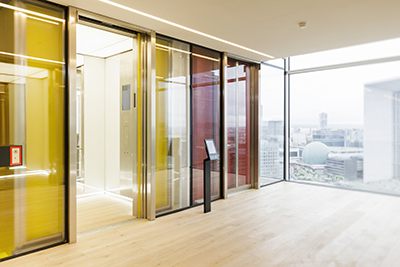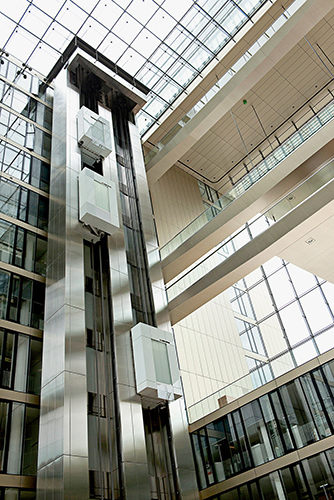The utilization of various cutting-edgetechnologies has ushered in a new era of elevator safety, fundamentallychanging the traditional reactive approach to safety into a proactive andpredictive endeavour.

Elevator safety has become of paramount concernas the demand for taller structures grows and urban infrastructure becomesincreasingly intricate. Technological advancements are revolutionizing verticaltransportation, enhancing its safety, efficiency, and convenience.
According to a recent study conducted byTechnavio, the elevator and escalator market in India is projected to expand byUS$784.24-million between 2022 and 2027, boasting a Compound Annual Growth Rate(CAGR) of 8.9 per cent. The industry's growth will be propelled by theproliferation of high-speed metro projects, a surge in disposable income, andeconomic development, and the increasing number of office spaces and commercialestablishments.
One of the most notable advancements in elevatorsafety is the implementation of real-time sensors designed to detectirregularities. As towering structures become more prevalent and urbaninfrastructure grows increasingly intricate, prioritizing elevator safety hasgained immense significance. This technology represents a profound andtransformative influence on elevator safety, transcending mere incrementalenhancements and reshaping the safety landscape significantly.

Elevatorsafety – Transformed by technology
Elevator safety is undergoing a fundamentaltransition because of cutting-edge technology breakthroughs. DestinationSelection Control (DSC) technology, for instance, streamlines passengerexperiences by efficiently assigning elevator vehicles to travellers heading tothe same location, lowering wait and travel times while minimizing crowding.
Smart elevators, powered by the Internet ofThings (IoT), not only monitor performance but also make real-time maintenancechoices, detecting, and preventing problems before they arise. Meanwhile,modern solutions, such as the ‘TWIN’ elevator, reduce energy usage whileaccommodating more passengers in the same shaft space.
With sheer speed, elevators whisking people fromground to pinnacle in minutes and transit management systems increasingefficiency, the future of elevator safety is defined by a marriage oftechnology and design, promising not only greater security but also increasedefficiency.
Sensorsto detect anomalies
Elevator sensors that identify anomalous behaviourare critical to guaranteeing passenger safety and elevator reliability. Belowis a breakdown of some typical elevator sensors and how they detect anomalous behaviour:
CableTension Sensors
Elevator cables oversee the transporting of theelevator car and its passengers. Cable tension sensors are used to continuouslymeasure the tension in these cables. Any odd conduct, such as an abrupt spikeor decrease in stress, can be a sign of a problem.
Thus, if a cable begins to fray or weaken, thesensor detects the change in strain and sends a warning. This early warningsystem aids in the prevention of cable failures, which could be dangerous.
BrakePerformance Sensors
An elevator's braking procedure is criticalfor safety during both normal operation and emergencies. The quality andperformance of the elevator’s brakes are continuously monitored by brakeperformance sensors.
They can send a warning if they identifyaberrant behaviour, such as increased wear or diminished braking efficiency.This assures that the elevator is removed from service for repair prior to asevere brake failure.
Sensorsfor Vibration and Acceleration
The elevator's vibration and accelerationsensors act as internal detectives. They regularly check the elevator'smovements and vibrations for anything out of the ordinary.
They promptly issue maintenance alerts if theydetect odd vibrations or accelerations that could signal mechanical faults,such as misalignment or imbalance. This preventative mechanism maintains theelevator working efficiently while maintaining passenger safety.
OverloadSensors
The vigilant defenders of elevator safety keeptrack of the combined weight of people and luggage in the elevator. When thisweight exceeds the safe limit, these sensors immediately stop the elevator frommoving until the excess weight is decreased. This proactive precaution assurespassenger safety as well as the elevator's structural integrity.
The VG beam sensor, which has an unlimitedcapacity and monitors weight through crosshead beam deflection, is a highlyrecommended solution for boosting safety in both new installations andmodernizations of larger cabins and goods elevators.
RemoteMonitoring Systems
Remote monitoring and control solutions showed anew era of elevator safety, significantly elevating its standards. In emergencysituations, the monitoring system acts as a vital lifeline, swiftlytransmitting critical information to first responders.
Beyond mere notifications, the system offersprecise location tracking, delivering real-time data on elevator status andpotential threats inside, thereby expediting rescue operations. This wealth ofinformation not only informs but also dramatically enhances the speed andsafety of passenger rescue efforts.
Furthermore, these solutions extend their impactbeyond safety, upholding sustainability by reducing electricity consumptionthrough intelligent elevator integration. Real-time monitoring and dataanalysis empower elevators to optimize their operations, effectively curbingenergy usage and operational expenses for building owners.
This eco-conscious approach aligns seamlesslywith global initiatives to reduce carbon footprints, seamlessly integratingelevators into the green construction movement. In doing so, they benefit bothpassengers and the environment, presenting a win-win situation that underscoressafety, convenience, and ecological responsibility.
Enhancinguser safety
Enhancing passenger safety within the elevatoris just one facet of an all-encompassing transportation experience thattranscends safety concerns. The elevator experience becomes more efficient withreduced waiting times, thanks to the seamless operation ensured by real-timemonitoring and predictive maintenance. Furthermore, proactive maintenanceprotocols guarantee the dependable operation of elevators, particularly inbustling buildings, ultimately leading to minimal downtimes and disruptions.
A few of the elevator precautions that need tobe maintained while riding in the elevator are:
- Prior to entering, passengers should waitfor others to leave.
- Passengers should never try to hold thedoors open or push others.
- It is advisable that passengers should neveruse a elevator during a fire; instead, go by stairs.
- Passengers should use the phone or theemergency button to call for assistance in an emergency.
- Passengers should be careful with youngchildren and animals in the elevator.
- Passengers should let the lift come to acomplete stop while getting out.
Conclusion
The utilization of various cutting-edgetechnologies has ushered in a new era of elevator safety, particularly in thecontext of ascending to unprecedented heights. This transformation is largelyattributed to innovations like smart elevators enabled by IoT technology, theincorporation of Cloud predictive space, and the adoption of cable-freeelevator systems.
These advancements have not only bolsteredsafety measures but also fundamentally changed the way we approach elevatorsafety. By integrating advanced sensors for anomaly detection and implementingremote monitoring systems, the traditional reactive approach to safety hasevolved into a proactive and predictive endeavour.